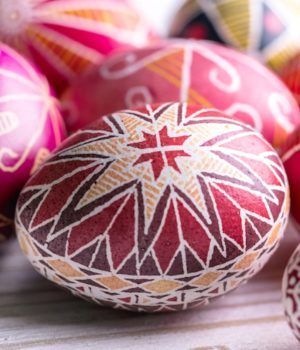Written by Zoe Manoukian
Egg decorating is speculated to be one of humankind’s oldest art forms, and dates farther than the age of great antiquity in which humans decorated ostrich shell in Africa. According to Stephanie Hall of the American Folklife Center, eggs “are part of the creation myths of many peoples, the ‘cosmic egg’ from which all or parts of the universe arises. They often symbolize life, renewal, and rebirth”. We have seen colorful eggs placed on the altar in celebrations of the new year throughout Eurasia, and pure white roasted eggs included in the seder plate of Passover.
The most elaborate eggs come from Eastern Europe, where wax is used in layering intricate designs. Hall identifies two tools used to apply the wax: the kistka, a funnel stylus used to make fine lines; and a round edged stylus used to drip wax, creating “elongated teardrops”. Once applied, the egg is dyed. These steps are repeated until finished. Ukrainian “pysanky” eggs predate Christianity and were originally exchanged as gifts to preserve health and reject evil. The fears and wishes that pysanky honor interact with the concrete world through the awareness that just as life is fragile, so too is the egg. In an interview with NPR, Pysanka artist Paul Wirhun stated that the egg is more than a symbolic object—it’s a powerful object as well. Moreover, as subject to the life cycle, the egg is just as testimonial as it is evocative: “It wasn’t just a representation of new life, it was new life”. For those who feel inspired by the pysanky technique, you can practice the implementation of wax at home. Try melting down Paraffin wax, or using a white crayon, to draw a design on your egg. Areas coated with wax will not be affected by dye. Dip your egg into your lightest dye. Continue adding more wax as you please, and be sure to move from light to dark colors.
The emergence of Christianity brought new tradition to the egg. Throughout the medieval period, the consumption of eggs was forbidden during Lent. Thus, eggs became an integral part of the Easter Sunday celebration. In 1290, Edward I purchased 450 eggs to be decorated. The German Easter egg hunt became popular in the United Kingdom in the 1800s when Queen Victoria’s German-born mother orchestrated hunts for the royal family at Kensington Palace. Historian Dr. Andrew Hann speculates that the eggs were hard-boiled with onion skins, as central European eggs were often dyed using lichens and vegetables. Northern British and Scandinavian eggs often have a leaf or floral impression which is achieved by placing a flower at the top of an egg before wrapping and boiling it. These eggs are called “pace eggs”, derivative of Pascha, the Latin word for Easter. To create your own natural dyes, bring 2 cups of water (and an optional 2 tablespoons of white vinegar). Then add a coloring agent and reduce for at least 30 minutes. Let cool for 2-3 hours, then place your egg into the dye. Leave it until you have achieved your desired color. Allrecipes.com suggests: 1.5 cups of shredded beats for purple/pink; 7 onion skins for rusty yellow; 3 tablespoons of turmeric or cumin for bright yellow; 3 tablespoons of chili powder for orange; 1.5 cups of shredded red lettuce for sky blue; and 2 cups of spinach for green. Leaving an egg in 2 cups of juice or coffee can also do the trick. To make your own pace egg, wrap an onion skin tightly around a leaf or flower placed on the egg.
For Easter of 1885, Czar Alexander III sought to charm his wife Maria Feodorovna, and commissioned jeweler and goldsmith Peter Carl Fabergé to make the first of 50 “immensely personal, yet gloriously flamboyant” eggs (Morton, 2019). These eggs are now considered to be the “last commissions of objets d’art” (faberge.com). For his first piece, Fabergé created a simple white egg which twisted open to reveal a golden yolk holding a golden hen holding a miniature diamond crown holding a ruby pendant. First deceivingly simple, the eggs grew to be evidently embellished as Fabergé decorated them with enamel, velvet, pearl, silver, diamonds, and rock crystal. Disruptions aside, the tradition lasted until 1917 when the Imperial family was executed following the Bolshevik’s February Revolution. Under Lenin’s orders, the royals’ valuables were packed and sent to the Kremlin, and in response to a tanking economy in the 1920s and 30s, Russian leaders sold the eggs. Presently, we are aware of the whereabouts of 42 Fabergé eggs—the remaining 8 are yet to be found. Though the lavish interior of a Fabergé egg might be difficult to replicate at home, the exterior can be replicated using a variety of creative embellishments. Make your own Fabergé egg by painting a beautiful design, or gluing whatever bits of fabric, glitter, gemstone, jewelry, beads, or other trinkets you can find.
The history of the decorated egg is vast and predates Christianity and the development of the Western world. Delicate and lovely, these eggs have withstood centuries of elegance, conflict, and evolution. By decorating our own eggs, we are not only reliving the childhood custom of spring time crafts, but we are paying homage to one of the world’s richest and most reverent artistic traditions.
Works Cited
Hall, S. (2017, April 6). The Ancient Art of Decorating Eggs. Retrieved April 6, 2020, from https://blogs.loc.gov/folklife/2017/04/decorating-eggs/
Hann, A. (2018, March 16). The history of the hunt: how an Easter tradition was hatched. Retrieved April 6, 2020, from http://blog.english-heritage.org.uk/the-history-of-the-egg-hunt/
How to Make 9 All-Natural Easter Egg Dyes. (n.d.). Retrieved April 6, 2020, from https://www.allrecipes.com/article/natural-easter-egg-dyes/
Morton, E. (2019, April 17). The Mysterious Fate of the Romanov Family’s Prized Easter Egg Collection. Retrieved April 6, 2020, from https://www.history.com/news/romanov-family-russia-mystery-faberge-easter-eggs
Shute, N. (2016, March 24). Easter Egg Art: Hatched From An Ancient Tradition To Celebrate Rebirth. Retrieved April 6, 2020, from https://www.npr.org/sections/thesalt/2016/03/24/471719770/eggs-become-art-to-celebrate-lifes-rebirth
The Imperial Eggs. (n.d.). Retrieved April 6, 2020, from https://www.faberge.com/the-world-of-faberge/the-imperial-eggs




